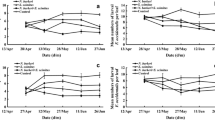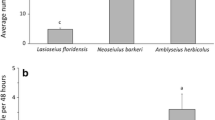Abstract
A 2-year survey of mite populations and pesticide use was carried out in Nova Scotia, Canada, in apple orchards where the two-spotted spider mite (Tetranychus urticae Koch) was the dominant phytophagous mite. Fungicides were the only class of pesticides that affected cumulative number ofT. urticae-days per leaf in tree canopies and colonization success — the ratio ofT. urticae-days to number of immigratingT. urticae caught in sticky bands on tree trunks. In 2000, increased numbers ofT. urticae-days in the tree canopy were associated with more frequent applications of ethylene bis-dithiocarbamate (EBDC) fungicides and with higher fungicide toxicity scores, which indicate cumulative level of suppression of the phytoseiid predatorTyphlodromus pyri Scheuten by all fungicide applications. Higher rates of colonization success were also associated with higher toxicity scores. EBDC’s applied in 2000 promotedT. urticae immigration as indicated by their counts on sticky bands. In 2000 and 2001, number ofT. pyri-days in the tree canopies was decreased by more frequent EBDC applications and by higher fungicide toxicity scores. Promotion ofT. urticae in tree canopies by EBDC’s was attributed to their toxicity toT. pyri. BothT. pyri and another phytoseiid,Amblyseius fallacis (Garman), were found in ground cover vegetation. Hence, increased immigration from the ground cover attributed to the toxicity of EBDC’s toT. pyri and, especially, toA. fallacis, which is a specialist predator of spider mites and an effective natural enemy ofT. urticae.
Similar content being viewed by others
References
Baillod, M. and Guignard, E. (1985) Typhlodromes, lutte biologique contre les acariens phytophages et programme de traitement.Rev. Suisse Vitic. Arboric. Hortic. 17:30–31.
Bernard, M.A., Horne, P.A. and Hoffmann, A.A. (2004) Developing an ecotoxicological testing standard for predatory mites in Australia: acute and sublethal effects of fungicides onEuseius victoriensis andGalendromus occidentalis (Acarina: Phytoseiidae).J. Econ. Entomol. 97:891–899.
Bostanian, N.J., Thistlewood, H. and Racette, G. (1998) Effects of five fungicides used in Quebec apple orchards onAmblyseius fallacis (Garman) (Phytoseiidae: Acari).J. Hortic. Sci. Biotechnol. 73:527–530.
Croft, B.A. and MacRae, I.V. (1992) Biological control of apple mites by mixed populations ofMetaseiulus occidentalis (Nesbitt) andTyphlodromus pyri Scheuten (Acari: Phytoseiidae).Environ. Entomol. 21:202–209.
Dunley, J.E. and Croft, B.A. (1990) Dispersal between and colonization of apple byMetaseiulus occidentalis andTyphlodromus pyri (Acarina: Phytoseiidae).Exp. Appl. Acarol. 10:137–149.
Gerson, U. and Cohen, E. (1989) Resurgences of spider mites (Acari: Tetranychidae) induced by synthetic pyrethroids.Exp. Appl. Acarol. 6:29–46.
Hardman, J.M. (1999) Biological and chemical mite control to increase fruit size.in: 135th Annual Report Nova Scotia Fruitgrowers’ Association, 1998. NSFGA, Kentville, NS, Canada. pp. 62–70.
Hardman, J.M., Franklin, J.L., Moreau, D.L. and Bostanian, N.J. (2003) An index for selective toxicity of miticides to phytophagous mites and their predators based on orchard trials.Pest Manag. Sci. 59:1321–1332.
Hardman, J.M. and Gaul, S.O. (1990) Mixtures ofBacillus thuringiensis and pyrethroids control winter moth (Lepidoptera: Geometridae) in orchards without causing outbreaks of mites.J. Econ. Entomol. 83:920–937.
Hardman, J.M., Jensen, K.I.N., Franklin, J.L. and Moreau, D.L. (2005) Effects of dispersal, predators (Acari: Phytoseiidae), weather, and ground cover treatments on populations ofTetranychus urticae (Acari: Tetranychidae) in apple orchards.J. Econ. Entomol. 98:862–874.
Hardman, J.M., Moreau, D.L., Snyder, M., Gaul, S.O. and Bent, E.D. (2000) Performance of a pyrethroid resistant strain of the predator miteTyphlodromus pyri (Acari: Phytoseiidae) under different insecticide regimes.J. Econ. Entomol. 93:590–604.
Hardman, J.M. and Rogers, M.L. (1998) New opportunities for mite control in Nova Scotian apple orchards.in: 134th Annual Report Nova Scotia Fruitgrowers’ Association, 1997. NSFGA, Kentville, NS, Canada. pp. 24–29.
Hardman, J.M., Rogers, M.L., Gaul, S.O. and Bent, E.D. (1997) Insectary rearing and initial testing in Canada of an organophosphate/pyrethroid-resistant strain of the predator miteTyphlodromus pyri (Acari: Phytoseiidae) from New Zealand.Environ. Entomol. 26:1424–1436.
Hardman, J.M., Rogers, R.E.L., Nyrop, J.P. and Frisch, T. (1991) Effect of pesticide applications on abundance of European red mite (Acari: Tetranychidae) andTyphlodromus pyri (Acari: Phytoseiidae) in Nova Scotian apple orchards.J. Econ. Entomol. 84:570–580.
Hardman, J.M., Smith, R.F. and Bent, E. (1995) Effects of different IPM programs on biological control of mites on apple by predatory mites (Acari) in Nova Scotia.Environ. Entomol. 24:125–142.
Hassan, S.A., Albert, R., Bigler, F., Blaisinger, P., Bogenschütz, H., Boller, E.et al. (1987) Results of the Third Joint Pesticide Testing Programme by the IOBC/WPRS-Working Group Pesticides and Beneficial Organisms.Z. Angew. Entomol. 103:92–107.
Henderson, C.F. and McBurnie, H.V. (1943) Sampling techniques for determining populations of the citrus red mite and its predators.U. S. Dep. Agric. Circ. 671.
Hislop, R.G. and Prokopy, R.J. (1981) Integrated management of phytophagous mites in Massachusetts (U.S.A.) apple orchards. 2. Influence of pesticides on the predatorAmblyseius fallacis (Acarina: Phytoseiidae) under laboratory and field conditions.Prot. Ecol. 3:157–172.
Johnson, D.T. and Croft, B.A. (1981) Dispersal ofAmblyseius fallacis (Acarina: Phytoseiidae) in an apple ecosystem.Environ. Entomol. 10:313–319.
Kreiter, S., Sentenac, G., Barthes, D. and Auger, P. (1998) Toxicity of four fungicides to the predacious miteTyphlodromus pyri (Acari: Phytoseiidae).J. Econ. Entomol. 91:802–811.
McMurtry, J.A. and Croft, B.A. (1997) Life-styles of phytoseiid mites and their roles in biological control.Annu. Rev. Entomol. 42:291–321.
Meyer, R.H. (1974) Management of phytophagous and predatory mites in Illinois orchards.Environ. Entomol. 3:333–340.
Nakashima, M.J. and Croft, B.A. (1974) Toxicity of benomyl to the life stages ofAmblyseius fallacis.J. Econ. Entomol. 67:675–677.
Nyrop, J., English-Loeb, G. and Roda, A. (1998) Conservation biological control of spider mites in perennial cropping systems.in: Barbosa, P. [Ed.] Conservation Biological Control. Academic Press, New York, NY. pp. 307–333.
Pogoda, M.K., Pree, D.J. and Marshall, D.B. (2001) Effects of encapsulation on the toxicity of insecticides to the oriental fruit moth (Lepidoptera: Tortricidae) and the predatorTyphlodromus pyri (Acari: Phytoseiidae).Can. Entomol. 133:819–826.
Sabelis, M.W. (1985) Predation on spider mites.in: Helle, W. and Sabelis, M.W. [Eds.] Spider Mites: Their Biology, Natural Enemies and Control. vol. 1B. Elsevier, Amsterdam, the Netherlands. pp. 103–130.
SAS Institute (1994) SAS/STAT User’s Guide, Vol. 2. SAS Institute, Cary, NC, USA.
Snedecor, G.W. and Cochran, W.G. (1989) Statistical Methods. 8th ed. Iowa State Univ. Press, Ames, IA, USA.
Author information
Authors and Affiliations
Corresponding author
Additional information
http//www.phytoparasitica.org posting Sept. 13, 2006.
Formerly, Atlantic Food and Horticulture Research Centre, now retired.
Rights and permissions
About this article
Cite this article
Hardman, J.M., Franklin, J.L., Jensen, K.I.N. et al. Effects of pesticides on mite predators (Acari: Phytoseiidae) and colonization of apple trees byTetranychus urticae . Phytoparasitica 34, 449–462 (2006). https://doi.org/10.1007/BF02981199
Received:
Accepted:
Issue Date:
DOI: https://doi.org/10.1007/BF02981199




